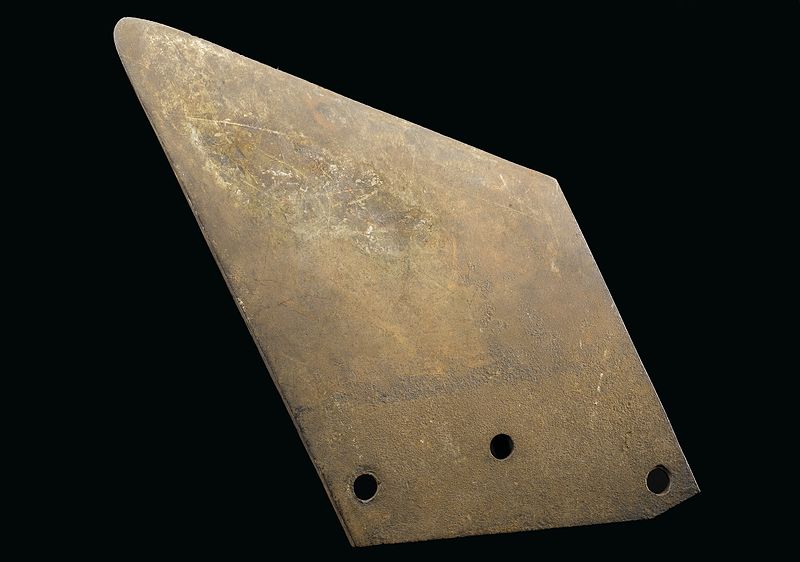File:Guillotine blade, France Wellcome L0057367.jpg

Original file (5,012 × 3,521 pixels, file size: 2.74 MB, MIME type: image/jpeg)
Captions
Captions
Summary edit
| Guillotine blade, France | |||
|---|---|---|---|
| Title |
Guillotine blade, France |
||
| Description |
Guillotine blade, France, 1794 Jean-Baptiste Carrier was a very unpleasant man. And on the 16th November 1794, this actual blade swiftly removed his head. In the wake of the French Revolution, Carrier had become a cruel and sadistic leader whose murderous actions were extreme even for those violent times. But eventually, he too stepped out of line and was himself sentenced to death. But, as he faced his end, why should he have had some small reason to thank a French doctor who had very different views on the nature of life and death? If you were condemned to execution by decapitation prior to 1792, you were probably in for a messy business. A sword was normally used, but if the executioner was inexperienced or the blade blunt, your head was unlikely to come off cleanly. An agonising death was guaranteed. But just two years before Carrier’s demise, doctor Joseph Ignace Guillotin advocated a ‘humane alternative’ – a never failing execution machine. Designed by fellow doctor Antoine Louis it became known as the “Guillotine” and it carried blades like this one. Guillotin had wanted to make the process short and painless, and the Guillotine was indeed incredibly efficient. But the device ensured that executions became even greater public spectacles. Ironically, Guillotin was against the death penalty and had hoped his machine would be a step along the road to abolition. So, do you think Guillotin would have been appalled at the reality of his ‘humane project’? Besides, can killing another human being ever be considered ‘humane’ or even ethical in the first place? And should doctors ever be involved in capital punishment? By the way, the guillotine was last used in France in 1977 and was not officially retired until the abolition of the death penalty there in 1981. Medical Photographic Library |
||
| Credit line |
|
||
| References |
|
||
| Source/Photographer |
https://wellcomeimages.org/indexplus/obf_images/6e/2e/a598aa4d2240ede1571d3b166cd8.jpg
|
||
Licensing edit
- You are free:
- to share – to copy, distribute and transmit the work
- to remix – to adapt the work
- Under the following conditions:
- attribution – You must give appropriate credit, provide a link to the license, and indicate if changes were made. You may do so in any reasonable manner, but not in any way that suggests the licensor endorses you or your use.
File history
Click on a date/time to view the file as it appeared at that time.
| Date/Time | Thumbnail | Dimensions | User | Comment | |
|---|---|---|---|---|---|
| current | 08:36, 17 October 2014 |  | 5,012 × 3,521 (2.74 MB) | Fæ (talk | contribs) | =={{int:filedesc}}== {{Artwork |artist = |author = |title = Guillotine blade, France |description = Guillotine blade, France, 1794 Jean-Baptiste Carrier was a very unpleasant man. And on the 16th November 17... |
You cannot overwrite this file.
File usage on Commons
The following page uses this file:
Metadata
This file contains additional information such as Exif metadata which may have been added by the digital camera, scanner, or software program used to create or digitize it. If the file has been modified from its original state, some details such as the timestamp may not fully reflect those of the original file. The timestamp is only as accurate as the clock in the camera, and it may be completely wrong.
| Short title | L0057367 Guillotine blade, France |
|---|---|
| Author | Wellcome Library, London |
| Headline | L0057367 Guillotine blade, France |
| Copyright holder | Copyrighted work available under Creative Commons Attribution only licence CC BY 4.0 http://creativecommons.org/licenses/by/4.0/ |
| Image title | L0057367 Guillotine blade, France
Credit: Science Museum, London. Wellcome Images images@wellcome.ac.uk http://wellcomeimages.org Guillotine blade, France, 1794 Jean-Baptiste Carrier was a very unpleasant man. And on the 16th November 1794, this actual blade swiftly removed his head. In the wake of the French Revolution, Carrier had become a cruel and sadistic leader whose murderous actions were extreme even for those violent times. But eventually, he too stepped out of line and was himself sentenced to death. But, as he faced his end, why should he have had some small reason to thank a French doctor who had very different views on the nature of life and death? If you were condemned to execution by decapitation prior to 1792, you were probably in for a messy business. A sword was normally used, but if the executioner was inexperienced or the blade blunt, your head was unlikely to come off cleanly. An agonising death was guaranteed. But just two years before Carrier’s demise, doctor Joseph Ignace Guillotin advocated a ‘humane alternative’ – a never failing execution machine. Designed by fellow doctor Antoine Louis it became known as the “Guillotine” and it carried blades like this one. Guillotin had wanted to make the process short and painless, and the Guillotine was indeed incredibly efficient. But the device ensured that executions became even greater public spectacles. Ironically, Guillotin was against the death penalty and had hoped his machine would be a step along the road to abolition. So, do you think Guillotin would have been appalled at the reality of his ‘humane project’? Besides, can killing another human being ever be considered ‘humane’ or even ethical in the first place? And should doctors ever be involved in capital punishment? By the way, the guillotine was last used in France in 1977 and was not officially retired until the abolition of the death penalty there in 1981. 1794 Published: - Copyrighted work available under Creative Commons Attribu |
| IIM version | 2 |
